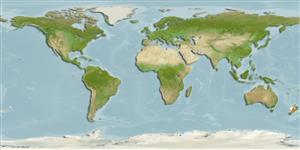Myxini (slijmprikken) (hagfishes) >
Myxiniformes (Hagfishes) >
Myxinidae (Hagfishes) > Eptatretinae
Etymology: Eptatretus: hepta (Gr.), seven; tretos (Gr.), perforated (i.e., with holes), referring to seven gill apertures on what would later be described as Homea banksii (=E. cirrhatus) [range within genus is 6-14 pairs of gill apertures]. (See ETYFish); cryptus: From kryptos (Gr.), hidden or secret, referring to its similar morphology to E. cirrhatus, with which it has been confused in the past. (See ETYFish).
Environment: milieu / climate zone / depth range / distribution range
Ecologie
marien bathydemersaal; diepte 96 - 922 m (Ref. 115309). Deep-water
Western Pacific: New Zealand.
Grootte / Gewicht / Leeftijd
Maturity: Lm ? range ? - ? cm
Max length : 93.1 cm TL mannelijk / geslacht onbekend; (Ref. 115309)
Korte beschrijving
Determinatiesleutels | Morfologie | Morfometrie
Dorsale stekels (totaal) : 0; Dorsale zachte stralen (totaal) : 0; Anale stekels: 0; Anale zachte stralen: 0. Diagnosis: characterized by the combination of the following characters: 7 pairs of gill pouches, 3/3 multicusps, 12–15 prebranchial slime pores (modally 14), 78–86 total slime pores, slime pores without narrow white rim, preocular length 4.8–5.8% TL, and body colour brown to dark brown; differs from all other congeners except E. caribbeaus, E. menezesi, E. strahani, E. cirrhatus, and E. goliath by having 7 pairs of gill pouches and 3/3 multicusps; Eptatretus caribbeaus, E. menezesi, and E. strahani are not found in New Zealand; differs from E. caribbeaus by the number of anterior unicusps (10–11 versus 11–13), posterior unicusps (8–10 versus 10–11), and body colour (brown to dark brown versus light tan); differs from E. menezesi by the tail slime pores (11–14 versus 14–18), total slime pores (78–86 versus 86–94), and ventral finfold colour (brown versus whitish margin); it differs from E. strahani by having visible (versus absent) eyespots, rounded (versus slit-like) 1st few branchial apertures, vestigial (versus welldeveloped) ventral finfold (0.17–0.64%TL versus 1.12–1.16%TL), rounded (versus angled) ventral caudal fin profile, and shallower tail depth (8.1–10.6%TL versus 10.9–12.7%TL); differentiation from E. cirrhatus by the prebranchial slime pores (12–15, modally 14 versus 15– 18, modally 16), its more robust appearance (body depth 8.9–12.0% TL versus 5.9–11.2% TL, often <8.6% TL), and body colour (brown to dark brown versus dark brown to purple-brown); some, and often most, slime pores of E. cirrhatus have a narrow white rim, whereas slime pores in E. cryptus sp. nov. are the same colour as the rest of the body; care must be taken not to interpret residual slime or internal structure of the slime pore for the presence of a white rim; Eptatretus cryptus differs from E. goliath by the trunk slime pores (46–54 versus 56–60) and total slime pores (78–86 versus 89–95); the following character can also help in dissociating E. cryptus from E. goliath: preocular length (>4.8 versus 3.7–5.2% TL) and prebranchial length (>20.3 versus 18.3–20.9% TL) (Ref. 115309).
This species is more commonly found deeper than 500 m. Its biology is largely unknown because it has been misidentified as the common hagfish E. cirrhatus; its stable carbon and nitrogen isotope signature indicated that this species feeds at a high trophic level, 3 levels above primary producers (Ref. 115309).
Levenscyclus en paargedrag
Maturities | Voortplanting | Spawnings | Egg(s) | Fecundities | Larven
Zintzen, V., C.D. Roberts, L. Shepherd, A.L. Stewart, C.D. Struther, M.J. Anderson, M. McVeagh, M. Noren and B. Fernholm, 2015. Review and phylogeny of the New Zealand hagfishes (Myxiniformes: Myxinidae), with description of three new species. Zool. J. Linnean Soc. 174:363-393. (Ref. 115309)
Status op de Rode Lijst van het IUCN (Ref. 130435)
Gevaar voor de mens
Harmless
Gebruik door de mens
Tools
Speciale rapporten
Download XML
Internetbronnen
Estimates based on models
Fylogenetische diversiteitsindex (Ref.
82804): PD
50 = 0.5000 [Uniqueness, from 0.5 = low to 2.0 = high].
Bayesian length-weight: a=0.00204 (0.00092 - 0.00452), b=2.93 (2.73 - 3.13), in cm total length, based on LWR estimates for this (Sub)family-body shape (Ref.
93245).
Trofisch niveau (Ref.
69278): 4.4 ±0.7 se; based on size and trophs of closest relatives
Weerstandsvermogen (Ref.
120179): laag, minimale populatieverdubbelingstijd 4,5-14 jaar (Preliminary K or Fecundity.).
Fishing Vulnerability (Ref.
59153): High vulnerability (57 of 100).
